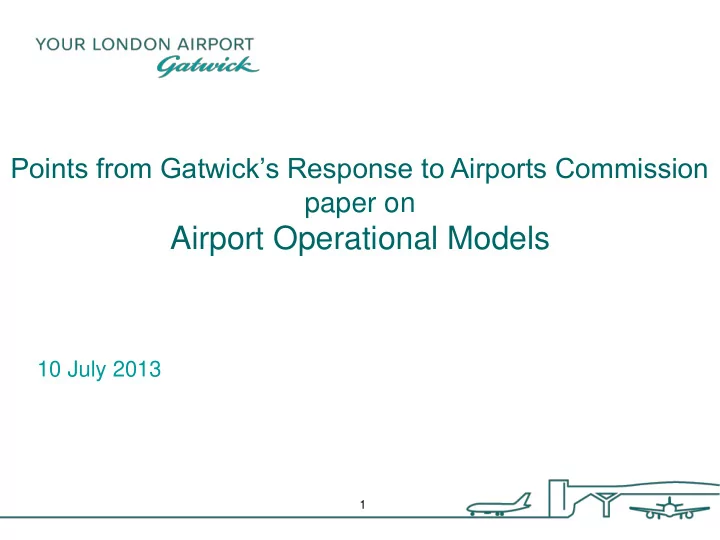

Points from Gatwick’s Response to Airports Commission paper on Airport Operational Models 10 July 2013 1
Aviation Futures 1. Continued liberalisation, further consolidation, further strengthening of alliances – dominant role of major focal airports is enhanced 2. Middle East and Far East carriers and airports cause focal airports in Europe to become increasingly by-passed 3. Integration of low-cost and full-service models sees more and more airports operating some level off “hub - style” models – weakening the dominant role of the focal airports • Data used as a basis for Future 1 may not be appropriate • Conclusions which lead to Future 1 must be checked against what has actually happened in the UK 2
Across all markets full service carriers account for nearly 40% of all seat capacity in the UK • Considering all market groups the LCC segment has now grown to over 35% of total capacity (seats) in 2013. This growth has been mostly organic though acquisitions have occurred (Go, Buzz, GB airways, BA Connect) • The combined share of full service carriers has declined from 73% in 1990 to under 40% today 3 Source: OAG (Aug considered) ICF Analysis
Aviation Futures 1. Continued liberalisation, further consolidation, further strengthening of alliances – dominant role of major focal airports is enhanced 2. Middle East and Far East carriers and airports cause focal airports in Europe to become increasingly by-passed 3. Integration of low-cost and full-service models sees more and more airports operating some level off “hub - style” models – weakening the dominant role of the focal airports • These Futures are not mutually exclusive • Continued change, which cannot be predicted with confidence, creates unavoidable uncertainty • It is essential to recognise that uncertainty, and to develop airport infrastructure which is robust and flexible in the face of changing market demands 4
Advantages, Disadvantages and Trade Offs • Advantages of the Hub Model – Potentially some additional connectivity – Attractive to network airlines • Disadvantages of the Hub Model – Noise, pollution and surface transport congestion (for those nearby) – Draws traffic away from regional airports – Less equitable distribution of costs and benefits – Market power and reduced competition (higher fares, less innovation, less choice) – Less flexibility to respond to future changes • Other Disadvantages of the Hub Model:- - Resilience, Passenger Experience, and (probably) Cost and Deliverability • Conclusions on the overall balance of Advantages/Disadvantages need to reflect assessments of the future Incremental Traffic and the existing Airport System • Gatwick’s view is that a Constellation of Three Two -Runway Airports will meet the needs of the UK and London better than a Mega-Hub 5
Points from Gatwick’s Response to Airports Commission paper on Airport Operational Models 10 July 2013 6
Recommend
More recommend